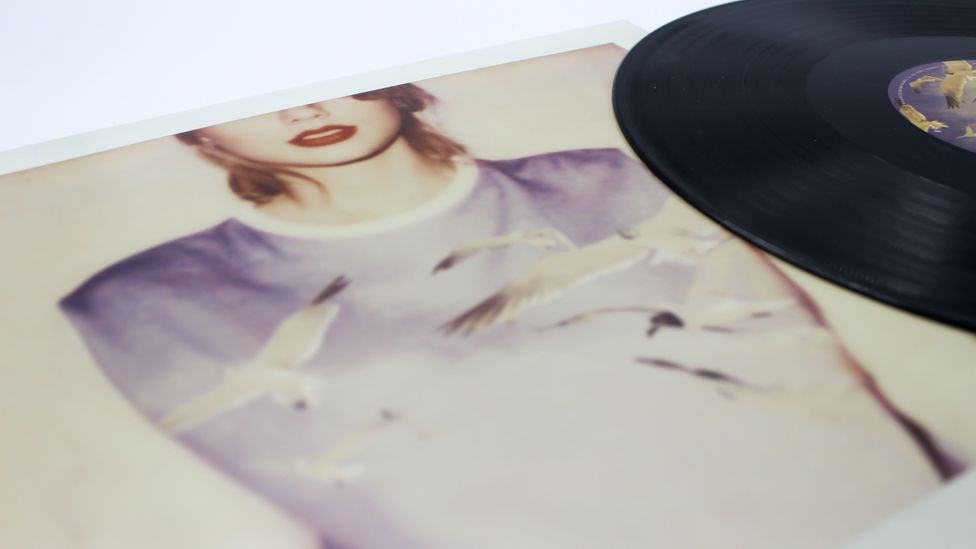With the announcement this week of Taylor Swift’s 1989 (Taylor’s Version), Rob Freeman revisits the moment that changed the artist’s career forever.
O
On Wednesday, Taylor Swift announced that the re-recorded version of her 2014 album 1989 was set to be released in October. Since 2021, pop music fans have been excitedly consuming these re-recorded albums, dubbed “Taylor’s versions”, which have been streamed more than 1 billion times – far outstripping the originals.
More like this:
– Can a parody song top the charts?
– The night hip-hop was born
– Why Sinead O’Connor was misunderstood
In 2019, music executive Scooter Braun acquired Swift’s previous record label Big Machine, taking ownership of her back catalogue before selling the Master tapes to an investment fund for a reported $300m. Embroiled for several years in a subsequent dispute, Swift decided to take back control by embarking on the project to re-record her entire back catalogue. Having worked through 2008’s Fearless and 2010’s Speak Now, and with the release in 2022 of 2012’s Red, her fans are revisiting this integral moment of Taylor Swift’s career – which saw the emergence of her “pop era”, and the reinvention of herself.
In a controversial move, Swift had chosen to step away from her country roots towards a more “alt-pop” direction on 2012’s Red. She brought in Swedish pop mega-producer Max Martin as collaborator, and singles I Knew You Were Trouble and We Are Never Ever Getting Back Together combined her traditional guitar sound with a more diverse set of influences, from EDM to dubstep. When the album was released, she faced a Dylan-esque backlash from her core, US country fanbase, but the move also found her an entirely new audience, in scores of pop music fans around the world.

Taylor swift 1989 album cover
But it wasn’t until her next album that Swift found the full expression of her new pop direction. 1989 was met with enthusiastic reviews the first time around in 2014: Billboard called it “a sophisticated tour-de-force”, while Rolling Stone said “it sounds like nothing she’s ever tried before”. And it’s fitting that Swift’s retrofuturist masterpiece should be returning to the mainstream nearly a decade after its first release. It is an album out of time, shuffling its influences and eras both musically and lyrically, through proleptic narratives of memory and loss, looking simultaneously backwards and forwards.
A message of hope
Created alongside friend, collaborator and Bleachers frontman Jack Antonoff, at the beginning of his own super-producer ascendency, 1989 is a pitch-perfect exercise in musicianship and album structure, with diaristic lyrics accompanied by lush synths and vocal percussion. From the liberal sprinkling of glossy ’80s synths throughout, to the washed-out Polaroid cover, the album is nostalgic, while brimful of anticipation about the future.
Opener Welcome To New York is on the surface about arriving in an overwhelming city with “a kaleidoscope of loud heartbeats”, but underneath is about starting again, perhaps after a failed relationship, dreaming of a new beginning. Album highlight Out of the Woods features a woman in the present remembering a relationship in the past, and looking forward to the future. “I remember thinking – are we out of the woods yet? Are we out of the woods? Are we out of the woods, yet? Are we out of the woods?”
The album’s message is one of hope, of making something beautiful out of something difficult. In her 1995 book, She Bop: the definitive history of women in popular music, Dr Lucy O’Brien writes that in pop: “there is the impression of both embattled strength and fragility. It is in Dusty Springfield’s taut notes, Chrissie Hynde’s jangling rock guitar, Amy Winehouse’s bluesy contralto.” And it is in Taylor Swift’s 1989.
With the release of the album, Swift gained – alongside a legion of new fans – a newfound respect from the wider music industry. She began to be referred to as an “auteur” rather than an artist, and the music publications that had previously ignored her started to pay attention. The alt-country musician Ryan Adams recorded an entire album of 1989 covers (met by some with a less-than-rapturous reception), and she became a permanent collaborator with Pitchfork darlings like Bon Iver’s Justin Vernon and The National’s Aaron Dessner.
1989 marked a turning point for Swift’s music, and a new relationship with her fans (at one point during the album’s press tour, she went so far as to publicly invite them to her house on television). Along with the energy she channels into her deeply personal yet relatable songwriting, she has put an equal amount of effort into the people who listen to her songs, creating a reciprocal relationship that has resulted in unwavering devotion among many. That’s why “Swifties” are so excited when she re-releases albums they first listened to the best part of a decade ago. At an awards ceremony in 2019, Taylor Swift said: “To the fans who come to the shows, who buy the albums, I just want you to know this one thing – you are the longest and best relationship I have ever had.”
1989 – Taylor’s Version will be released in October.
If you liked this story, sign up for the weekly bbc.com features newsletter, called The Essential List. A handpicked selection of stories from BBC Future, Culture, Worklife and Travel, delivered to your inbox every Friday.
If you would like to comment on this story or anything else you have seen on BBC Culture, head over to our Facebook page or message us on Twitter.





